Are These Unprecedented Times?
Contributing Writer John Milas ’28, reflecting on violence, polarization, and historical parallels, asks whether today’s turbulence is truly unprecedented and argues that while history offers lessons, it cannot substitute for fresh perspectives in confronting America’s current political crisis.
These are unusual times, aren’t they? It appears that the old vogue of genial discourse and picturesque legality has run its course. In its place is a new America, a frustrated America, an America boiling in a broth of anger. Norms once considered bedrock to our culture, such as free expression, are under threat from both government harassment and now vigilante violence. Indeed, Charlie Kirk’s murder has brought the latter development back to the forefront of political discussion. Right on the grounds of a university, the apparent house of free debate, bullets rang. Few would consider such an event “normal.” Many would say that these are unprecedented times.
I venture to test that alarming claim against American history, in the hope of accurately understanding the neurotic ditch we have found ourselves in. Perhaps current events roughly mirror old episodes in our history. Perhaps there are precedents that can shine light on today. Perhaps the scent of violence and uproar may not be as foreign to America as we have come to expect.
Indeed, if we look towards the late 19th century, we will find a familiar scene. Historian John Grinspan wrote that then, just as now, Republicans and Democrats treated each other like separate nations, flanked by their own partisan newspapers and wide casts of loyal troops. Accordingly, their elections were hotly contested; the four presidential elections from 1876 to 1888 ranked among the eight closest in history. That polarization prompted bloodshed, particularly in violent labor strikes where workers and capitalist agents squared off. Sometimes, the zeitgeist of violence clawed upwards to the White House, as four presidents were assassinated from 1865 to 1912.
The raucous era only lost its deadly edge after Progressive reformists took the reins. They aggressively worked to “clean up” the political scene, but the marks of the time period still linger in history. Those bloody prints tell us something: Clearly, underneath its smoke-ridden skies, we can locate familiar scenes within the Gilded Age’s violent pulse.
For some people, the comparison is oddly consoling. After all, the theory goes, if we’ve survived one “Age of Acrimony,” then we can outlast another. Even legislators have found solace in the idea, asking authors like Grinspan to explain how reformers saved the country then, so that their example can guide us forward. This notion appears logical; the old wisdom is, after all, that the past reveals the future. I, too, once held fast to it.
Yet, I've concluded that this interpretation is erroneous. True, valuable insights can be gleaned from an old era of rough party politics and public violence. But to suggest that history is simply cycling through its phases, and that quality democracy will glide into our lap once we reenact an old dance, is dangerous.
Grinspan himself acknowledged this in an interview with Politico, rejecting the notion that the sanitized democracy of the 20th century was measurably “better” than the Gilded Age. To understand this, consider that Progressive reformers “sanitized” democracy by displacing the power of underclass bosses in favor of educated elites. Through these efforts, mainstream electoral politics became relatively peaceful, but also detached from mass culture, instead operating in the gentle plane of elite dynamics. Perhaps the Progressive scaffolding served not to curtail public mudslinging but only to remove it from electoral politics. But then, rowdy rhetoric could slither into the common world, amidst the streets and bars beyond elite vision, until it had radicalized enough to rise to the shore, pincering the establishment from both the left and right.
Even if you find this polite style of politics more appealing, or you’ve devised some other democratic model in its place, the Gilded Age offers scant advice. Beyond the familiar stench of animosity, so much of the then is alien to the now. Yes, back then, everyday politics were certainly noisy, but the party platforms remained clustered over a similar set of views, such as laissez-faire economics and white supremacy. Rarely, until the Populists in the 1890s, did they draw apart on the political spectrum. So, I would compare the parties more to sports teams (whose fans are boisterous but ultimately regulatable) than modern, ideational coalitions (whose worldviews never converge). The latter kind delivers a more entrenched polarization, one that existed during the Gilded Age only on issues of civil rights and not partisan politics. Contemporary America has seen it be extended to the mainstream and further guided along by professional political operatives who devise perfect schemes to further factional loyalties.
Parties today are also not captained by some cigar-smoking, provincial bosses, as they were back then. They are movements that orbit specific personalities, who appropriately become the centers of violence. Take, for instance, President Donald Trump. Trump could never have reigned 140 years ago. Even in the Gilded Age, the president was expected to respect electoral institutions and people, and even if they didn’t, they lacked the expansive, imperial powers that their office now possesses.
So, when the violent aura ruminates not flashes of anarchy but rather from an ideological, imperial president, a new issue inevitably emerges. Perhaps the most fundamental difference between public violence now and then is that it never threatened to completely overthrow democracy. This is true throughout all of American history; regardless of the political temperature, the presidential election was always upheld as legitimate among mainstream circles. The inclusiveness of that democracy was, of course, limited, for only white men could vote. Yet the power of that narrow electorate was never suspended (particularly on the presidential level). The same cannot be said today; the stability of the most fundamental principle of our civic reality, the election, is within the crosshairs of opportunism and violence.
Clearly, then, these are unprecedented times. Not in an aesthetic or insignificant way, but in the very fiber of our political operations. At first glance, the death of Charlie Kirk parallels bygone days, but the roots and correlated threats surrounding that murder prove to be unique. This does not mean that studying history is a lost cause here. On the contrary, only that filter could have separated the precedent from the unprecedented, bringing to light the alien properties that now ensnare our attention. Other active studies of history, including those with a more global orientation, serve the same purpose.
But there lies the kernel of this article — activity. The notion that history merely rolls back into its old lessons will leave us in a serpentine trance. What is needed is not a retrospective healing but unique and forthright perspectives. So, forgo the comforting thought that the present moment can be met with rusty tools. Of course, history guides all thoughts, but the pernicious threat is in relying largely on old concepts and conditions, those that will leave us mystified by the unprecedented winds the future holds for America.





Comments ()